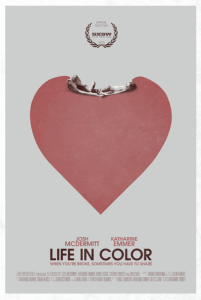Life in Color
Written and directed by Katherine Emmer
USA, 2015
Life in Color is in the running for having the most contrived meet-cute at this year’s SXSW festival. Mary (Katherine Emmer), a dour live-in nanny and all-around sad sack, is chaperoning her ten-year-old charge’s birthday party when she comes across the party clown smoking pot by the garbage cans. After her employer catches her taking a toke, Mary loses her job as well as her home. The party clown, named Homer (Josh McDermitt), proposes that she come stay with him while he house-sits for a friend. She reluctantly agrees. Over the next month, they overcome personal adversities together, develop a strong romantic connection, and learn to rise above past hardships through honesty and laughter. Unfortunately, they’ll be the only ones laughing, as Life in Color is completely devoid of humor and wit.
The film would be much improved if Emmer — who stars in the film she also wrote, produced and directed — took a word of advice from her own screenplay. In a bid to make some fast cash, Homer decides to enter a comedy competition. The problem is he isn’t funny. Much of his set is steeped in trivial, insipid subject matter – have you ever noticed how delis load your sandwich with shredded lettuce but skimp out on the other condiments? – and he has trouble connecting to his audience. Mary, who Homer promises to give a cut of the winnings, advises him to use more personal material in his comedy. Audiences find it easier to relate to humor when they find it to be sincere. Mary’s words are true. They are also painfully ironic.
Life in Color’s comedy utterly lacks honesty. It is founded solely on kooky antics and shocking character behavior. Case in point, during the film’s most reprehensible section, Mary secures a temporary nanny position, and she and Homer supervise a grim-faced teenager while the girl’s parents are out of town. Mary almost immediately loses track of her ward, who escapes from her bedroom window in the middle of the night. Rather than search for the girl or contact the police, Mary and Homer choose to spend the next several days indulging in fun and relaxation at her employer’s home. The characters’ utter indifference toward the girl’s disappearance is mined for comedy, but such behavior is too far-fetched and deplorable for the laughs to land.
Another issue that hampers the viewer’s ability to engage with the film is the insufferable nature of the protagonist. Emmer intends Mary to be seen as a downtrodden woman who has given up hope on finding personal fulfillment. Instead she comes across as a lazy, selfish individual, someone who constantly rides on the backs of others just to stay afloat. Though she experiences personal growth by film’s end, it comes far too late to remedy the shameful behavior she exhibits throughout much of the narrative.
If Life in Color has one saving grace, it is the strong chemistry between Emmer and McDermitt. The two have an easy rapport with each other, and their relationship makes considerable strides toward allowing viewers to empathize with Mary. In a film that remains largely devoid of sincerity, Mary and Homer’s romance provides a few fleeting glimpses of truth.
— Jacob Carter



